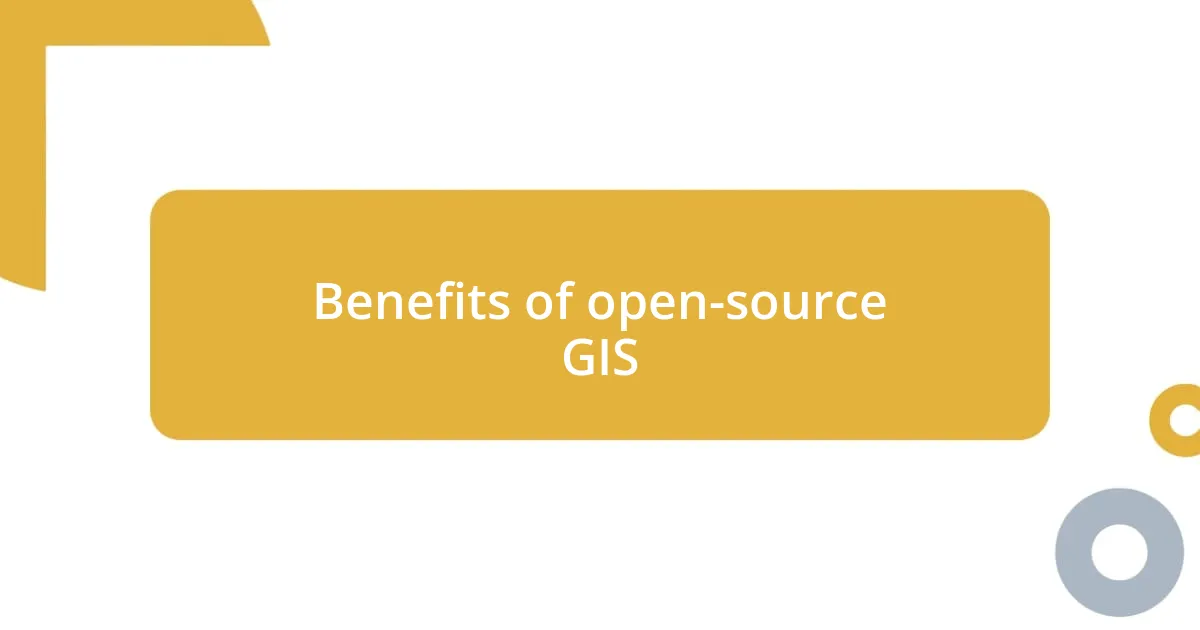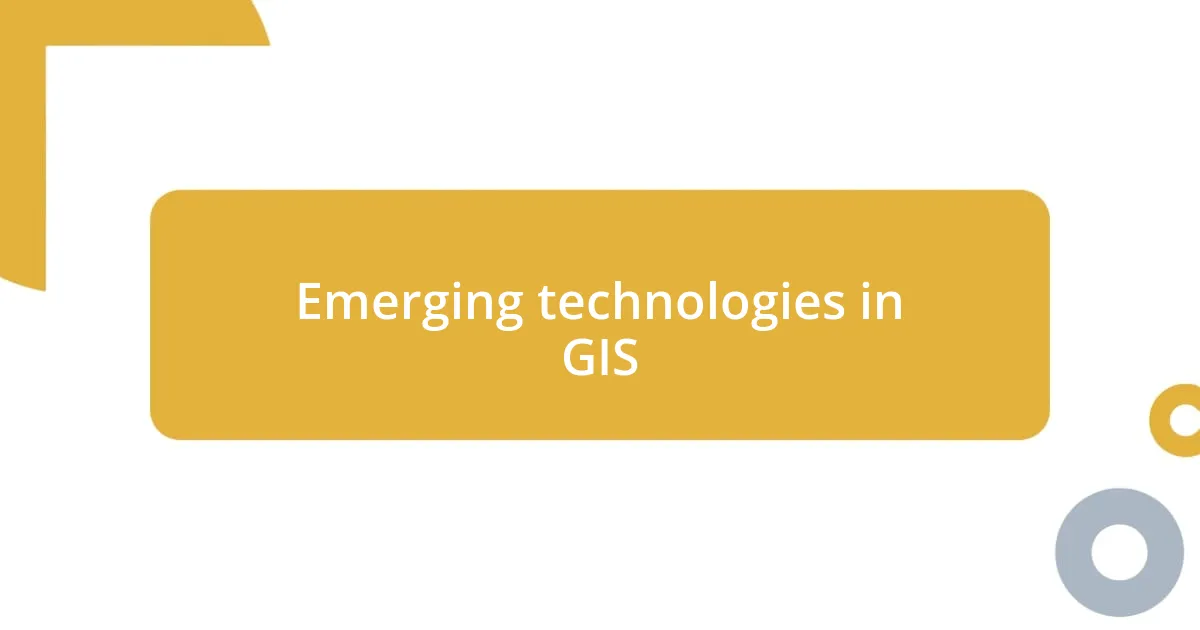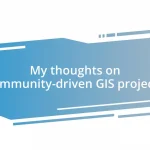Key takeaways:
- The future of open-source GIS is promising, with community-driven innovation, AI integration, and democratization of access shaping its evolution.
- Key benefits include cost-effectiveness, collaboration among users, and flexibility in customizing tools to meet specific needs.
- Challenges like insufficient documentation, funding issues, and software fragmentation must be addressed to enhance user experience and adoption.
- Community contributions and diverse inputs play a crucial role in development, leading to impactful changes and solutions in various sectors, including urban planning and disaster management.

Future of open-source GIS
As I look ahead, the future of open-source GIS feels vibrant and full of potential. I remember a project I worked on a few years ago that relied on an open-source platform; the collaboration among developers was incredible, and that experience made me realize how community-driven innovation can spark unprecedented growth. Will we see even more contributors joining these projects as the world increasingly values transparency and accessibility in technology?
Moreover, I believe the integration of artificial intelligence with open-source GIS will revolutionize the way we analyze spatial data. Just thinking back to how I once navigated complex datasets using traditional tools—it was labor-intensive and time-consuming. As we harness AI’s capabilities within open-source frameworks, I can only imagine the efficiencies we’ll gain. It’ll be exciting to see how this influences decision-making across various sectors, don’t you think?
It’s not just about the technology itself; it’s also about democratizing access to GIS tools. I once spoke with a GIS enthusiast in a developing country who was limited by expensive software, yet had brilliant ideas that could transform local infrastructure. This highlights a crucial future component of open-source GIS: leveling the playing field for users around the globe. As we move forward, I genuinely hope we focus on cultivating diverse voices and ideas within the community, ensuring everyone’s contributions are valued.

Benefits of open-source GIS
When I think about the benefits of open-source GIS, the first thing that comes to mind is the cost-effectiveness. I remember working on a community mapping project where we saved significant resources by using open-source tools. That freedom from costly licenses allowed us to allocate funds to training sessions for local volunteers, empowering them to contribute meaningfully to the project.
Collaboration is another invaluable aspect. In one of my experiences with open-source GIS, I discovered that sharing knowledge and skills among users and developers was a game-changer. I distinctly recall joining an online forum where experts freely exchanged tips and techniques, which accelerated my learning. This culture of collaboration fosters innovation, ensuring that the tools evolve to meet real-world needs.
Flexibility is also a standout feature of open-source GIS. Unlike proprietary systems, I appreciated how customizable open-source software was to fit specific project demands. For example, on a particular project, I tailored a GIS application to incorporate community feedback directly, enhancing our local engagement efforts. This adaptability not only addresses individual user needs but also encourages creativity in problem-solving.
| Benefits | Details |
|---|---|
| Cost-effective | Open-source GIS reduces software expenses. |
| Collaboration | Encourages knowledge sharing and innovation. |
| Flexibility | Allows customization to meet specific user needs. |

Challenges in open-source GIS
While the promise of open-source GIS is exciting, several challenges linger that can impact its growth and adoption. I’ve encountered instances where the lack of comprehensive documentation left me and others feeling lost or frustrated. It’s like trying to navigate a new city without a map; the learning curve can be steep, and it can sometimes discourage potential users from embracing these tools.
Here are some specific challenges that I believe we should keep an eye on:
- Documentation and usability: Insufficient or outdated documentation can hinder user experience, making it difficult for newcomers to get started.
- Funding and resources: Many projects rely on volunteer contributions, which can lead to inconsistent updates and support.
- Fragmentation: With numerous open-source tools available, it can be overwhelming for users to choose the right solution for their needs.
- Quality assurance: The open nature of development might result in variable quality of the software, impacting reliability and user trust.
I’ve also had moments where I’ve needed to reach out for support in forums, and while I appreciated the helpfulness of the community, I craved a more centralized resource for troubleshooting. This experience truly underscored the importance of reliable support systems within the open-source ecosystem to nurture a thriving community.

Emerging technologies in GIS
Emerging technologies in GIS are reshaping how we interact with spatial data, and I find this development fascinating. For instance, the integration of artificial intelligence (AI) in GIS is something I’ve become increasingly excited about. I recently experimented with AI algorithms that analyze geographical patterns. The insights I gained were not only impressive but also opened the door to new analyses that I never thought possible.
Another innovation impacting GIS is the use of drones for data collection. I remember attending a workshop where a colleague demonstrated drone mapping techniques. It was eye-opening to see how drones could capture high-resolution imagery in a fraction of the time it traditionally takes. I often wonder how many more projects could benefit from this technology if we embrace it more widely.
Lastly, the rise of cloud computing is transforming how we store and process geospatial data. In my experience, having access to robust cloud platforms has made it easier for teams to collaborate in real-time, regardless of geographical boundaries. I feel that this technological shift will ultimately democratize GIS, allowing more people to contribute innovative solutions to pressing spatial challenges.

Community contributions to GIS
Community contributions to GIS play a vital role in shaping its evolution and accessibility. I vividly remember the first time I collaborated on an open-source GIS project. It was exhilarating to see a group of passionate individuals come together, pooling their skills and knowledge to refine a mapping application. There’s something deeply satisfying about creating something meaningful with others who share the same goal.
The impact of community contributions is often underestimated. One particular instance stands out for me: a colleague sought help to troubleshoot issues with software features. The quick responses from community members transformed what could have been a frustrating experience into a learning opportunity filled with support. This kind of engagement not only strengthens the software but fosters a sense of belonging among users. Isn’t it remarkable how a simple question can lead to vibrant discussions that enhance our collective understanding?
Moreover, I find it inspiring to see how diverse voices contribute to GIS projects. Recently, I joined a community-driven effort to improve open data accessibility for underserved neighborhoods. It was not just about the data; it was about giving a voice to those who often don’t have one in geographic discussions. Engaging with individuals from different backgrounds brought fresh perspectives to the table, reinforcing my belief that every contribution, no matter how small, can lead to impactful changes in our spatial landscape.

Case studies of successful GIS
One of the most striking case studies I’ve encountered is the use of GIS in urban planning for the city of Amsterdam. The city implemented an open-source approach to develop a comprehensive mapping tool that allows citizens to visualize urban changes. I recall the first time I tested the tool; seeing my own neighborhood reflected in real-time adjustments filled me with a deeper appreciation for inclusivity in planning. Don’t you think it’s remarkable how technology can bridge the gap between residents and decision-makers?
Another fantastic example involves the work done by non-profits in disaster management, particularly after Hurricane Harvey in 2017. They utilized open-source GIS to create real-time evacuation maps that proved vital for affected communities. When I read stories of individuals safely navigating chaotic situations because of this resource, I felt an overwhelming sense of hope. How often do we witness technology saving lives in such drastic circumstances?
Finally, I can’t overlook the impact of GIS in environmental conservation efforts. A project I followed closely utilized open-source GIS to map endangered species’ habitats in the Amazon Rainforest. The collaborative nature of this initiative allowed various stakeholders to contribute their data, creating a robust tool for conservationists. Reflecting on how collective action can lead to the preservation of our planet’s most vulnerable ecosystems gives me optimism for the future. Are we ready to harness this potential for greater good?

Predictions for GIS development
Looking ahead, I envision an exciting wave of innovation in GIS as artificial intelligence continues to evolve. I recently experimented with a GIS tool that integrated AI-driven analytics, and the insights it generated were nothing short of astonishing. It made me wonder: how much more could we unlock when we pair traditional mapping techniques with cutting-edge technology?
Moreover, I predict a growing emphasis on user-friendly interfaces in GIS applications. I remember struggling with complex platforms in the early days of my GIS journey. Now, as I see many tools prioritizing intuitive design, I can’t help but feel optimistic about attracting broader audiences. Who wouldn’t want to engage with GIS if it feels accessible and natural?
Lastly, the idea of open-source GIS being a cornerstone in addressing global challenges resonates deeply with me. In a recent webinar, I heard discussions about its potential to aid in climate resilience efforts, which sparked my imagination. Isn’t it thrilling to think about how our collective knowledge can be harnessed to solve pressing issues like urban heat islands and water shortages? As we unify our efforts, the future of GIS could very well be a catalyst for significant societal change.














